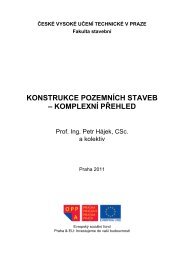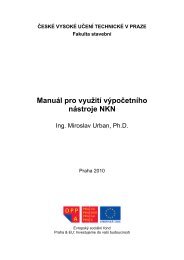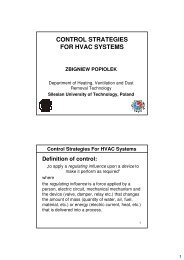Buses, Protocols and Systems for Home and Building Automation
Buses, Protocols and Systems for Home and Building Automation
Buses, Protocols and Systems for Home and Building Automation
You also want an ePaper? Increase the reach of your titles
YUMPU automatically turns print PDFs into web optimized ePapers that Google loves.
1. Basic categorization<br />
Evropský sociální fond. Praha & EU: Investujeme do vaší budoucnosti.<br />
<strong>Building</strong> automation systems <strong>and</strong> protocols can be divided into a plenty of categories using<br />
very different rules. In this wide set of classification properties we can determine some basic<br />
<strong>and</strong> interesting classifiers: openness, centralization or versatility of a system. These<br />
categories provide us important in<strong>for</strong>mation which is crucial in assessing usability of a<br />
protocol or a system <strong>for</strong> a project.<br />
1.1. System openness<br />
This property describes dependency of a system on a manufacturer. There exist two<br />
essential categories:<br />
• Open protocols (KNX, LON, BACnet, DALI, OpenTherm, EnOcean…)<br />
• Closed systems (Ego-n, iNels, Nikobus, XCom<strong>for</strong>t)<br />
Open protocols are based on open st<strong>and</strong>ards or open specifications, which are accessible <strong>for</strong><br />
everybody (who pay some fee) – not only <strong>for</strong> the manufacturer who developed the protocol.<br />
It is common that everything about the protocol is managed by a special association, not by<br />
the developer company. The most significant advantage of this approach is evident: open<br />
specification ensures a big flexibility <strong>for</strong> the building control system designer because there<br />
usually exist more than one manufacturer of a device with a desired function. Differences<br />
between devices are in a price, design or additional functions. Another advantage is that<br />
these protocols are supported by significant academic research producing new nontraditional<br />
features to the system (<strong>for</strong> example TU Wien is one of the leading research<br />
facilities <strong>for</strong> the KNX protocol). One of disadvantages of open protocols is usually the price of<br />
the system <strong>for</strong> family <strong>and</strong> small houses. These systems are cost-effective <strong>for</strong> bigger <strong>and</strong> large<br />
buildings, such as office buildings, hospitals, hotels or airports. Examples of some st<strong>and</strong>ards<br />
which cover the most important building automation protocols are KNX - EN 50090 <strong>and</strong><br />
ISO/IEC 14543, Lon - ANSI/CEA 709.1, BACnet – ASHRAE/ANSI 135 <strong>and</strong> ISO 16484-5.<br />
Specification (e.g. communication protocol) of a closed system is, in opposite to open<br />
protocols, not public to everyone – it is private to the developer company. There exist some<br />
exceptions – <strong>for</strong> example Eaton company <strong>and</strong> their Xcom<strong>for</strong>t system, where they offer the<br />
specification of their communication protocol in some cases to manufacturers who can add<br />
new features into their system. Closed building automation systems are closer to the end<br />
user than the open protocols – you can buy components (sensors <strong>and</strong> actors) of these<br />
systems in “supermarkets” like OBI, Hornbach or Baumax. The advantage are the prices of<br />
the components <strong>and</strong> of the whole system <strong>for</strong> family houses, flats or small houses. Usually<br />
these systems are very easy to install <strong>and</strong> to “program” (often without a computer). Closed<br />
systems are, in the most of cases, able to solve all the basic task of home automation. But<br />
they do not offer big versatility – a user can choose only from a very small group of devices<br />
<strong>and</strong> designs. Another problem is that users are dependent on one producer only <strong>and</strong> when<br />
the manufacturer stops the production of the devices, there will be a problem with the<br />
expansion of an installation <strong>and</strong> with replacement of crashed devices.<br />
Ondřej Nývlt - <strong>Buses</strong>, <strong>Protocols</strong> <strong>and</strong> <strong>Systems</strong> <strong>for</strong> <strong>Home</strong> <strong>and</strong> <strong>Building</strong> <strong>Automation</strong> 3

















